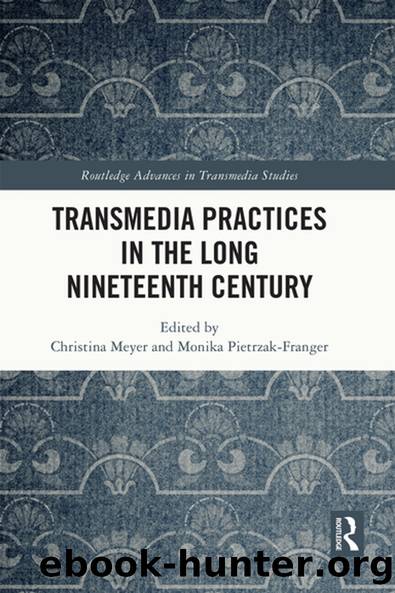Transmedia Practices in the Long Nineteenth Century by Christina Meyer Monika Pietrzak-Franger

Author:Christina Meyer, Monika Pietrzak-Franger [Christina Meyer, Monika Pietrzak-Franger]
Language: eng
Format: epub
ISBN: 9781000542868
Goodreads: 59140692
Publisher: Routledge
Published: 0101-01-01T00:00:00+00:00
Part II
Crossroads of fact and fiction
6
Transmedia practices toward a popular cultural sphere
Lippard, Thompson, and nineteenth-century serialities
Lisanna Wiele
DOI: 10.4324/9781003222941-8
Introduction
Perhaps no genre in the nineteenth century encapsulates the defining processes of serialization, adaptation, and appropriation of the period as forcefully as the antebellum city mystery novel, which began with the French roman-feuilleton and quickly became an âinternational vogueâ (Sollors 104) in the 1840s and 50s. Alongside the evolution of a globally expanding network of print media and communications, a âculture of dense, enmeshed serialityâ (Turner 197) emerged. And while serial narratives became, as Franco Moretti has pointed out âthe true protagonist of cultural lifeâ (150), so did their transmedia circulations, creating a horizontal permeation of the cultural sphere within a budding âera of collective intelligenceâ (Jenkins, âTransmedia Storytelling 101â). The sudden and ever-increasing flood of information offered through the dense seriality of antebellum print culture was marked by an ongoing âtension between abundance and limitationâ and, consequently, an âexcess of material, a spilling over the edgesâ (Turner 209).
This process of slopping over, this âexcess of materialâ could not be accommodated by print alone, but rather triggered various, often-chaotic, transmedia practices, expanding narratives from their original source. Utilizing the idea of a transmedia archaeology (Scolari et al.) and viewing transmedia storytelling, as scholars have,1 as a (loose) network of texts or narratives, expanding a fictional universe in various media, this chapter traces the channels and media of proliferation of a popular, bestselling genre beyond the printed page. Centering on the transmedia practices that played a key role in the transnational popularization of the city mystery novel, I aim to show that the genre succeeded, if not necessarily as systematically as Henry Jenkins suggests, in the dispersion of âintegral elements of a fictionâ that created a âunifiedâ (entertainment) experience and provided innovative contributions to the âunfolding of the storyâ (Jenkins, âTransmedia Storytelling 101â), as well as to its opportunities for public reception. The iterations and re-iterations of the city mysteries in and across different media are representative of the nineteenth-century mediascape and in fact reminiscent of the dynamics described by Christina Meyer and Monika Pietrzak-Franger in their introduction to this volume â the expansion of storyworlds (or tropes, concepts, or iconic character traits from a narrative) via illustrations, the theater, politically charged campaigns and merchandise surrounding the texts.
This chapter utilizes, primarily, George Lippardâs The Quaker City; or, The Monks of Monk Hall (1845) as well as Ned Buntlineâs Mysteries and Miseries of New York (1849) as case studies to examine the practices and processes transforming the city mysteries from serial pamphlet to book-bound novel and then to the stage, spilling over each medium into public political discourse and transnational movements such as the abolition of slavery. I argue that the initial serial character of the city mysteries in the periodical press triggered a development that was able to accommodate the âspillâ of the textsâ potentially explosive political agenda, which targeted social inequality in urban centers and harshly critiqued the exploitation of the lower classes by the upper ten thousand.
Download
This site does not store any files on its server. We only index and link to content provided by other sites. Please contact the content providers to delete copyright contents if any and email us, we'll remove relevant links or contents immediately.
Women and Jewish Marriage Negotiations in Early Modern Italy by Howard Tzvi Adelman(407)
Warrior King by Wilbur Smith(365)
18 real-life stories of serial killers and murderers with solved and unsolved killings from the USA, UK, Europe, and beyond. by Ben Oakley(285)
The Battle of Austerlitz by 50minutes(280)
Violence and Emotions in Early Modern Europe by Susan Broomhall;Sarah Finn;(274)
Who's Who in the Zulu War, 1879: The British by Adrian Greaves Ian Knight(272)
The American Crisis by Unknown(264)
Youth, Heroism and War Propaganda: Britain and the Young Maritime Hero, 1745â1820 by D. A. B. Ronald(239)
The Seeker by S. G. MacLean(229)
The Origins of French Absolutism, 1598-1661 by Alan James(220)
The Dutch East India Company and British East India Company: The History and Legacy of the Worldâs Most Famous Colonial Trade Companies by Charles River Editors(212)
The Traitor of Colditz by Robert Verkaik(200)
A Genius for Confusion by Richard M. Fried(199)
The Thirty Years War â Complete by Friedrich Schiller(199)
Invisible Worlds by Peter Marshall(198)
Fires of Faith by Catholic England under Mary Tudor(196)
Interest and Connection in the Eighteenth Century by Jacob Sider Jost(194)
The Opium Wars: Exploring the Addiction of Empires from Beginning to End by Ramos Adrian & Compacted History(193)
The Slave Trade in Africa by Simon Webb;(193)
